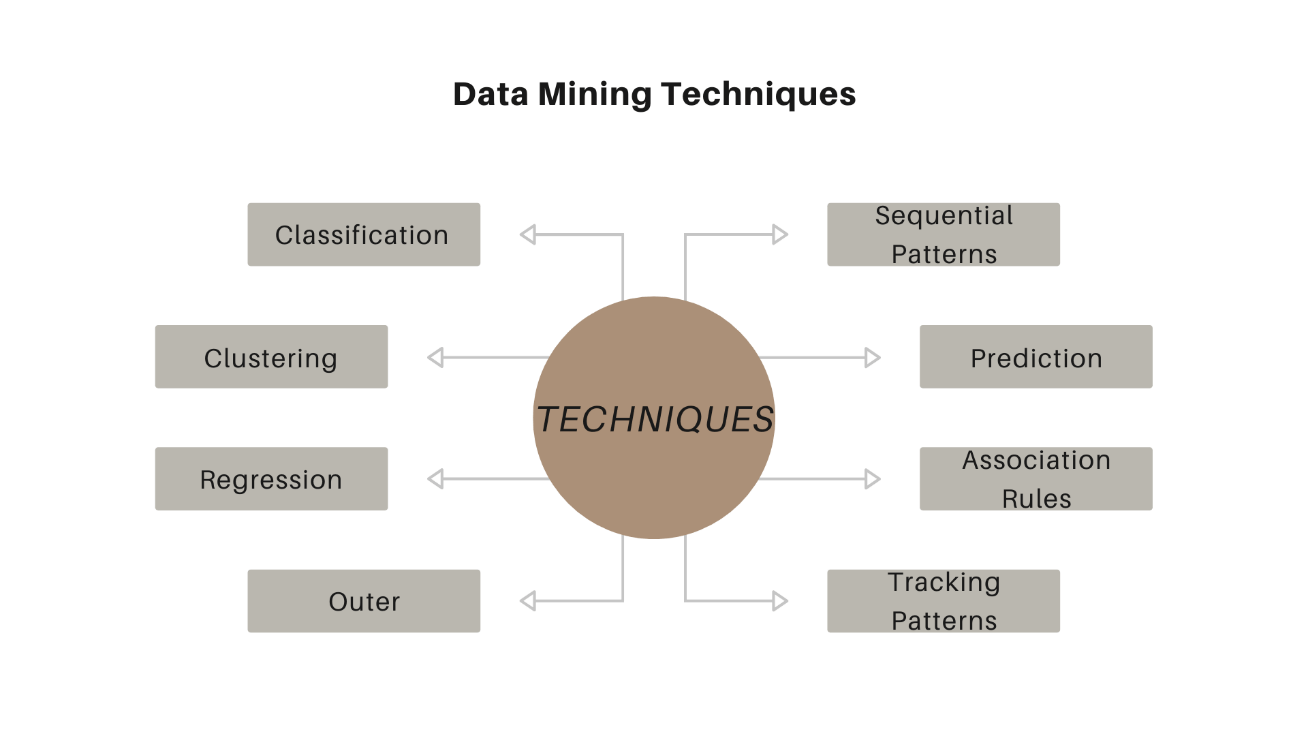Data Mining Techniques
Data Mining Techniques

Let us discuss each one of these techniques in detail:
Classification:
The technique used for obtaining important and relevant information about data and the metadata is called classification. As we already know the literal meaning of classification is to categorize the given set of information or data according to some criteria.
Data mining techniques can be further classified into different categories, as we can see that below:
- Classification of Data mining frameworks based on the type of data sources that are mined:
We can classify the data on the basis of the type of data that is being managed by a person for example, the multimedia, the spatial data, the data in the form of text, time-series data, World Wide Web, among others. - Classification of data mining frameworks on the basis of the various database involved:
This is the classification on the basis of the databases involved. For example. Object-oriented database, transactional database, relational database, are among the few to name. - Classification of data mining frameworks on the basis of the type of knowledge that’s discovered:
This type of classification mostly depends on the kind of knowledge discovered in various process of Data Mining. For instances, discrimination, classification, clustering, characterization, etc. - Classification of data mining frameworks based on the of data mining techniques:
The classification based on the data analysis approach, for instances the neural networks, machine learning, genetic algorithms, visualization, statistics, data warehouse-oriented or database-oriented, etc.
This type of classification also takes into consideration, the level of user interaction involved in the procedure of data mining.
Clustering:
Clustering can be defined as an analytics technique that heavily depends on the visual approaches in order to understand the data. The mechanism in Clustering displays the graphics so as to show where the distribution of data is. In this type, the colors are used to show the distribution of data.
Using a Graphical approach is ideal for cluster analytics because with the help of graphs and clustering, the users are easily able to see the distribution of data so that the trends are identified which are relevant to the business objectives.
Regression:
Regression can be defined as a technique of data mining that is most often used to predict a range of numeric values (or continuous values), that are provided to the user in a specific set of data. Regression is a widely used concept. It is used across the multiple industries mainly for planning marketing strategies, forecasting finance related matters and analyzing the trends.
Outer:
Outer detection is also called Outlier Analysis and Outlier mining. Outer is a type of data mining technique in which there is a full examination of particular data objects in a set of data that do not equate to the expected pattern or trend. This technique is very helpful as it can be used in a big variety of domains, such as intrusion, detection, fraud, fault detection, and so on.
Sequential Patterns:
This type of data mining technique is used for discovering a series of events that has taken place in sequence. It is notably very useful/beneficial for transactional mining of data. To give an example, we can say that this technique is used to reveal what items of hand accessories that a customer is more likely to buy after an initial purchase of let’s say, a clothing item. The sequential patterns help us in understanding the general trends of a customer’s need. In this way, organization can recommend additional items to the customers so as to exponentially increase its sales.
Prediction:
Prediction is an extremely powerful and very beneficial feature/quality of data mining that is responsible for representing one of four branches of analytics (the other branches are descriptive, diagnostic, and prescriptive). Let us take an example for understanding better, let’s say- a manager of a well- respected organization has to predict how much the customers of their products or services are likely to spend during the sale that organization has offered. In that example, the manager will have to predict something. This process will take place with the help of a model or a predictor that will help in predicting the information.
Association Rules:
Association Rules is a data mining technique that is very beneficial as we can search the association between two or more Items, data or information. It helps in discovering the hidden pattern or trend in a given data set. To explain in simpler yet apt language, this technique helps us in identifying or finding engaging associations or relations within various large sets of data.
Tracking Patterns:
Tracking patterns is an essential data mining technique. In this technique, the user identifies and monitors pattern or the trend that are usually seen in the data we are. It helps in making intelligent inferences about outcomes of business. If a certain organization is able to figure out and then determine that a product, they are selling is more popular than the other products sold by that very organization, the organization will be able to use that information in order to create products or services that are similar to the best sellers.